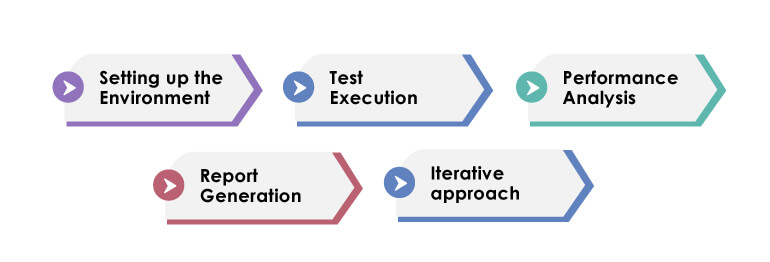Recommended Blogs
Continuous Performance Testing: Making DevOps Environment More Efficient

Content
- Continuous Performance Testing: An Overview
- Why Does Continuous Performance Testing Matter?
- Benefits of Continuous Performance Testing for DevOps driven Businesses
- How Does Continuous Performance Testing Work?
- Conclusion
- How TestingXperts Helps Businesses with Continuous Performance Testing?
Continuous Performance Testing: An Overview
Continuous performance testing is a methodology for continuously monitoring and evaluating the performance of software applications throughout the software development lifecycle. It involves the use of automated tools to simulate user behavior, generate loads, and measure the application’s response time, throughput, and resource utilization under various conditions. Continuous performance testing is an essential part of the DevOps and Agile development process, which emphasizes collaboration, automation, and continuous delivery. It also plays a critical role in driving successful DevOps transformation, ensuring performance validation is seamlessly integrated into modern delivery pipelines.
Continuous performance testing is often implemented using a combination of tools and technologies, such as load testing tools, monitoring tools, and performance analytics platforms. The main goal of continuous performance testing is to identify performance issues early in the development process, enabling teams to address them before they impact end-users. By continuously testing the application, developers can also ensure that new features and changes do not introduce performance regressions, which can cause slowdowns, crashes, and other issues.
Continuous performance testing typically involves the following steps:

Defining Performance SLAs: Identify the key performance SLAs that the application needs to meet, such as response time, throughput, error rate, and resource utilization.
Creating Performance Tests: Create automated performance tests that simulate user behavior and generate load on the application.
Executing Performance Tests: Execute the performance tests on a regular basis, such as daily or after every code change, to continuously monitor the application’s performance.
Analyzing Results: Analyze the performance test results to identify performance issues and bottlenecks and prioritize them based on their severity and impact on end-users.
Report and Remediate: Report the performance issues to the development team and remediate them by fixing the code, optimizing the infrastructure, or adjusting the application configuration.
Why Does Continuous Performance Testing Matter?
Continuous performance testing is an essential approach for organizations in the current digital age. It provides a way to measure and monitor the performance of applications, websites, and other digital services over time. Continuous performance testing helps organizations identify performance issues quickly and take corrective action before they become significant problems. This helps to ensure that customers have a good experience with the organization’s digital products and services.
This QA process also helps digital businesses ensure that their applications are able to handle increased load or traffic without any degradation in performance. With more and more people using their applications, it is essential for organizations to make sure that their applications can handle the load without any issues. The process helps businesses do just that by providing real-time feedback on how the application is performing under various load conditions.
Continuous performance testing also allows businesses to track usage patterns, which can help them better understand customer needs and improve their products accordingly. Additionally, data from continuous performance testing can be used to detect anomalies or malicious activities on an application or website, helping organizations protect their systems from cyber-attacks. Finally, continuous performance testing results can be used to identify areas of improvement to optimize performance and increase customer satisfaction.
Benefits of Continuous Performance Testing for DevOps-driven Businesses

Continuous performance testing is essential for the DevOps-driven business models as the process ensures that the application meets the performance requirements consistently. Here are some of the key advantages of continuous performance testing for DevOps-based digital businesses:
Improves Quality:
Continuous performance testing helps identify performance bottlenecks early in the development cycle. This way, developers can fix the issues before the application goes into production, which ultimately improves the quality of the application.
Enhances User Experience:
Applications that are slow or unresponsive can have a negative impact on the user experience. Continuous performance testing ensures that the application is performing optimally, which leads to a better user experience.
Saves Time and Money:
By identifying performance issues early in the development cycle, continuous performance testing helps save time and money. It is much more expensive to fix performance issues in production than in the development cycle.
Provides Continuous Feedback:
Continuous performance testing provides developers with continuous feedback on the performance of the application. This feedback helps developers make informed decisions about performance improvements and optimizations.
Supports Agile Development:
Continuous performance testing is essential in Agile development. It ensures that the application meets performance requirements in each iteration and allows developers to quickly respond to performance issues as they arise.
How Does Continuous Performance Testing Work?

Continuous performance testing is a process that aims to continuously monitor the performance of an application or system throughout the software development life cycle. It involves automated testing against various performance SLAs, including response time, throughput, and scalability, to identify and fix performance issues early in the development cycle. Here’s how continuous performance testing works:
Setting up the Environment:
First, the testing environment is set up with the required hardware, software, and network infrastructure. This includes configuring the load testing tool, creating test scripts, and defining the performance metrics to be measured.
Test Execution:
The load testing tool is used to simulate user traffic and generate load on the system under test. The tool can generate traffic from multiple virtual users, each simulating a real user interaction with the application, performing a specific action on the system.
Performance Analysis:
During the test execution, the tool captures performance metrics such as response time, throughput, and resource utilization. These metrics are analyzed to identify any bottlenecks or performance issues in the system.
Report Generation:
Once the test is completed, a detailed report is generated highlighting the performance metrics and any performance issues that were identified during the test. Developers use this report to fix the identified performance issues and improve the system’s performance.
Iterative Approach:
The performance testing process is repeated continuously throughout the development cycle to ensure that any new code changes do not adversely affect the performance of the system. This helps to catch performance issues early in the development cycle and avoid any performance-related issues in production.
Conclusion
Continuous performance testing allows digital businesses to stay ahead of the competition by ensuring that their applications are always running at optimal levels. By regularly monitoring and analyzing an application’s performance, organizations can quickly identify areas where improvements can be made in order to enhance user experience and increase customer satisfaction. Evidently, continuous performance testing is essential in today’s world as it helps organizations keep up with the ever-changing technology landscape while ensuring that their applications are always running at peak performance levels.
How TestingXperts Helps Businesses with Continuous Performance Testing?
TestingXperts (Tx) is a leading provider of performance and load testing services for businesses across domains. Tx has experience with all industry-leading performance testing and monitoring tools, along with expertise in end-to-end application performance testing services, including network, database, hardware, etc. With a highly skilled team of performance testers, Tx helps businesses benchmark their application performance. Tx provides customized test results reports to clients that help them make informed decisions.
At TestingXperts, our Continuous Performance Testing services are designed to help businesses achieve their performance goals by ensuring that their applications and systems are always running smoothly. We use the latest tools and technologies to provide real-time monitoring and early detection of performance issues, which enables us to quickly address any problems that arise.
By testing applications and systems for performance issues, TestingXperts helps businesses avoid downtime, prevent slow response times, and manage other problems that can result in lost revenue, damage to brand reputation, and unhappy customers.
Our Continuous Performance Testing Service offer:
Early Detection of Performance Issues: Detect performance issues early on in the software development lifecycle and save time and money on expensive fixes.
Real-time Monitoring: Our real-time monitoring and tracking system measures application performance to detect issues as they arise and helps take action to resolve them before they impact users.
Increased Agility: Helps businesses become more agile by providing them with the ability to quickly and easily make changes to their applications and systems without fear of introducing performance issues.
Reduced Costs: By identifying and addressing performance issues early, businesses can save money on expensive downtime and lost revenue.
Improved User Experience: Helps to ensure that applications and systems are always functioning optimally, which leads to improved user experience and increased customer satisfaction.
Leverage Tx-Perfkit
Tx-Perfkit is a first-of-its-kind Performance Testing and Monitoring Accelerator developed by TestingXperts Test Center of Excellence (TCoE). Tx-Perfkit is a unique and exclusive in-house framework that provides the following key benefits:
• Ensure QA cost savings of up to 30%
• Can be integrated with DevOps CI/CD pipeline
• Covers all stages of performance testing, followed by performance engineering
• Helps implement a shift-left approach for performance testing
• Helps to increase the overall profitability of a performance testing engagement
• Can be deployed on cloud or on-premise infrastructure to generate load on the Application Under Test (AUT)
• Quickly monitor the application infrastructure in one go
• Helps to load test blockchain and IoT applications
Discover more
Stay Updated
Subscribe for more info
